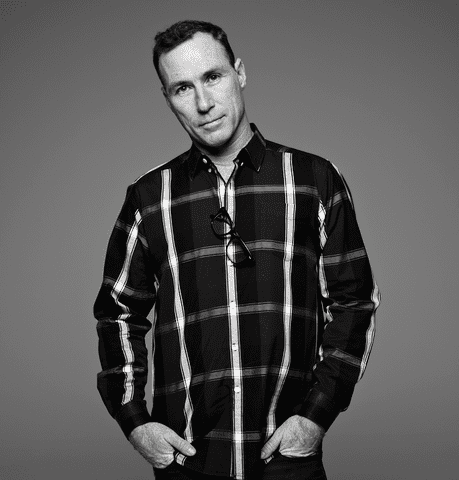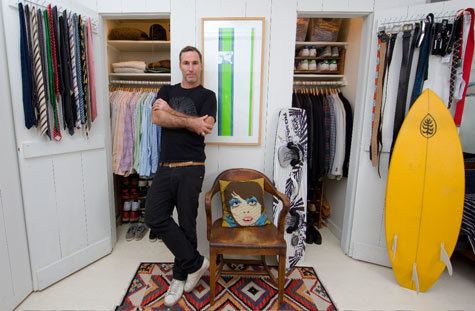Name Joel Fitzpatrick | ||
 | ||
Education Bennington College, Dunn School, Los Olivos | ||
Joel fitzpatrick skate
Joel Fitzpatrick (born January 6, 1968) is a lighting and architectural designer, artist and entrepreneur based in New York City.
Contents

Early life
Fitzpatrick was born in Maine and raised in California to a French mother and American-Irish father. He attended The Dunn School, a co-ed boarding school in Los Olivos, California and began his entrepreneurial career there, giving haircuts, selling vintage clothing and keeping two Coca-Cola vending machines on campus. He attended Bennington College in Vermont, where he majored in Sculpture and Lighting Design. Characters in both Bret Easton Ellis Rules of Attraction and The Secret History by Donna Tartt are based on Fitzpatrick.
Career
In the early '90s, Fitzpatrick launched a lighting company called Double Happiness that provided lighting equipment and other related services to Los Angeles-area rock clubs, venues, raves and private events. At the same time, he was pursuing a Masters Degree in Theater Design at California Institute of the Arts. He learned Lighting Design for Modern Dance there, and made conceptual art films and designed lights for everything from operas in Paris to touring African dance troupes. Fitzpatrick also worked as a lighting designer for well-known Los Angeles promoters Brent Bolthouse and Mike Messex.
While pursuing his master's degree, Fitzpatrick began making hand-screened, politically themed T-shirts in his Hollywood backyard. From those, he launched first fashion brand, Pleasure Swell, in 1993. His punk rock meets-surfer aesthetic defined the brand. The line also re-imagined the concept of Americana kitsch, turning men's Adidas polo shirts into women's dresses and making fashion-forward versions of classic 1950s and 1960s pieces. Pleasure Swell sold at Fred Segal, Urban Outfitters, dELiA*s and at hundreds of boutiques around the world.
He opened his first store, Swell, with money he made by borrowing $90 from his bookkeeper and playing craps for 24 hours straight in Las Vegas, and with contributions from several investors. He opened a second store, Ether, in 1994.
Hush Puppies
In 1995 Fitzpatrick converted half of his retail space into a shop that sold Hush Puppies shoes exclusively. A 25-foot inflatable basset hound - the company's logo - sat atop the building. Pee-Wee Herman (Paul Reuben) bought a few pairs from the shop and word of mouth quickly spread. He began flying to the company's headquarters in Rockford, Michigan, working with them to expand their range of designs. When they refused to make women's sizes, Fitzpatrick got them to agree to produce bigger sizes of the narrower child's shoe and in turn sold those to his female clientele. He also developed and sold his own exclusive designs, like glow-in-the-dark Hush Puppies, some made out of Kevlar, and a blue suede pair that tapped into his Americana kitsch vibe. Suddenly Hush Puppies became ubiquitous. Joel's celebrity clientele included Sarah Jessica Parker, Ellen DeGeneres, Jeanne Tripplehorn, Anjelica Huston and three of the five 1995 Academy Award nominees for Best Actress: Susan Sarandon, Sharon Stone and Elisabeth Shue. The New York Times compared the brand to Gucci and Tod's. The Council of Fashion Designers of America named Hush Puppies the Top Accessory of 1995. Malcolm Gladwell wrote an article in The New Yorker based on Joel's foresight and success, and secured his first book contract for the best-selling The Tipping Point, on that article. In 1996, Fitzpatrick was nominated for the California Designer of the Year award along with BCBG founder Max Azria, Mossimo founder Mossimo Giannulli and designer Janet Howard.
Fashion
Fitzpatrick opened another Ether shop in 1999 on Prince Street in New York, noted as the first to feature L.E.D. lighting in a retail space, and a Swell store on Lafayette Street. He continued to design clothing and showed two collections at New York Fashion Week in Bryant Park. The first was a group show, Girls Rule, which also featured the designs of Tatiana von Furstenburg, Planet Claire and Oliver Dow. The second was sponsored by Hush Puppies and featured dresses made from vintage 1950s men's sweaters with matching suede shoes.
In 2000, Fitzpatrick launched an interior/architectural design studio and also began working on Chemistryset, a line of home accessories with a 30-person sales force and five showrooms. In 2006, his show "Recreation in Ether" was shown at the Forbes headquarters in Manhattan.
Fitzpatrick is now focusing on architectural and lighting design in private homes as well as commercial properties. He has designed conceptual lighting for a series of art shows curated by Vladimir Restoin-Roitfeld (son of French Vogue editor-in-chief Carine Roitfeld), including building a temporary gallery at the Fifth Avenue flagship Armani space in Manhattan for artist Richard Hambleton, and the former Essex Street meat market in the Lower East Side for Nicolas Pol's first American exhibition. He is also a licensed real estate salesperson and is currently designing a line of home accessories and custom chandeliers and lighting installations for public and private spaces. Fitzpatrick's name is on a residential townhouse on West 4th Street in the West Village where a dramatic light installation can be seen nightly. The townhouse is currently listed for sale.
